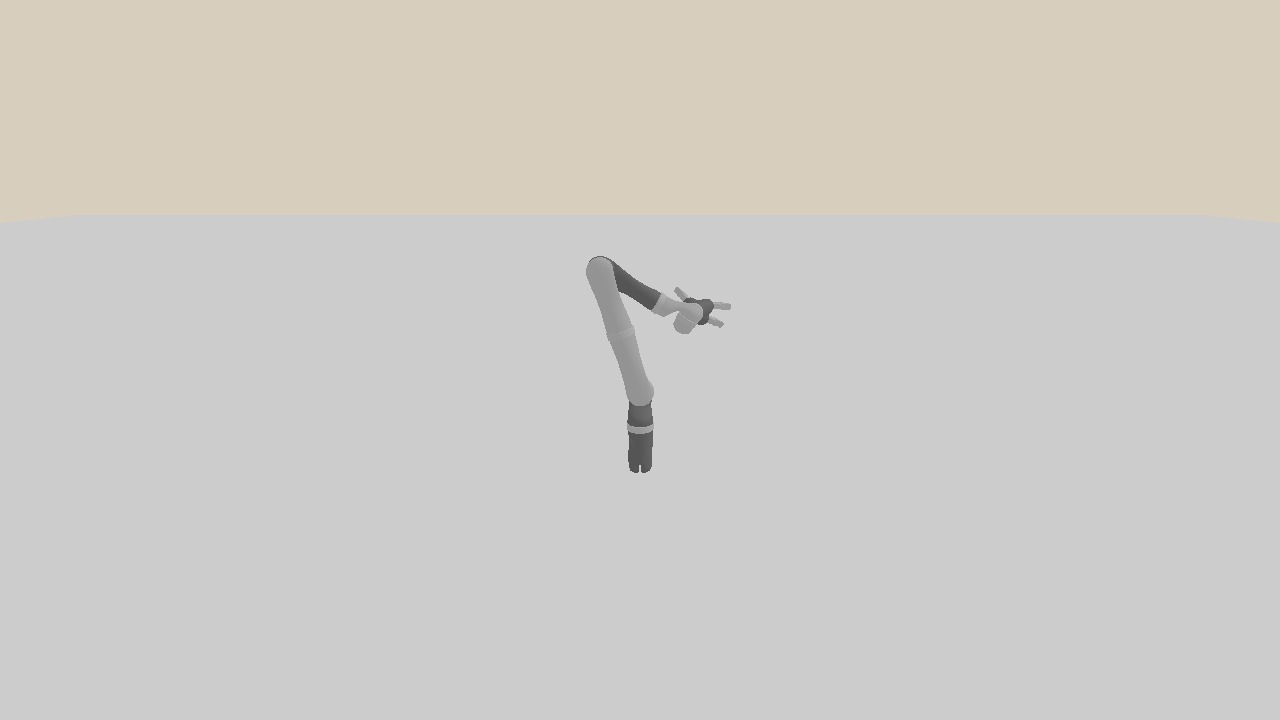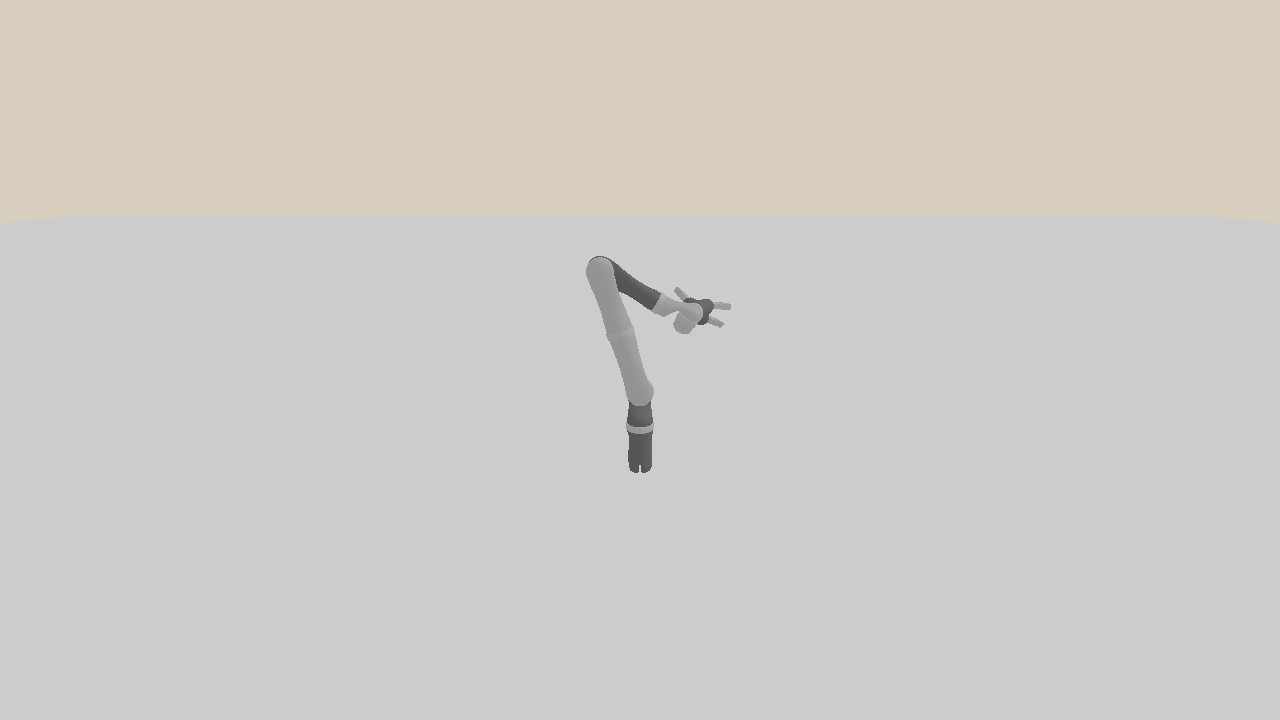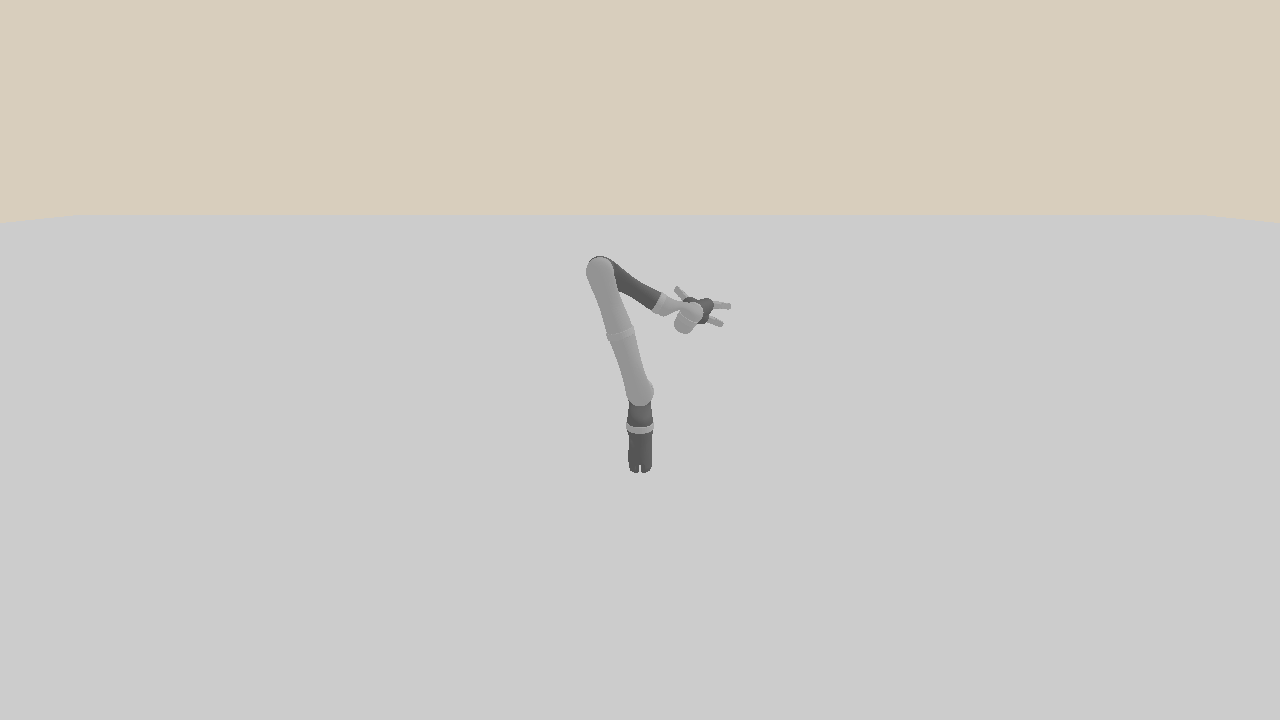Getting Started with Robot#
Note
This tutorial assumes you have read the get started section. The assets (robot) and full scripts can be found at here.
In this tutorial, you will learn the following:
Load a robot (URDF)
Set joint positions
Compensate passive forces
Control the robot by torques
Set up the engine, renderer and scene#
First of all, let’s set up the simulation environment as illustrated in Hello World.
scene = sapien.Scene()
scene.add_ground(0)
scene.set_ambient_light([0.5, 0.5, 0.5])
scene.add_directional_light([0, 1, -1], [0.5, 0.5, 0.5])
viewer = scene.create_viewer()
viewer.set_camera_xyz(x=-2, y=0, z=1)
viewer.set_camera_rpy(r=0, p=-0.3, y=0)
Load a robot URDF#
Robots models provided by robot manufacturers are commonly represented in the URDF XML format. In this tutorial, we take Kinova Jaco2 arm as an example.
loader = scene.create_urdf_loader()
loader.fix_root_link = fix_root_link
robot = loader.load("assets/jaco2/jaco2.urdf")
robot.set_root_pose(sapien.Pose([0, 0, 0], [1, 0, 0, 0]))
Note that URDF loader has the fix_root_link property. If it is set to true
(by default), then the root link of the robot will be fixed. Otherwise, it is
allowed to move freely.
The robot is loaded as PhysxArticulation, which is a tree of links connected
by joints. We can set the pose of its root link through set_root_pose(...).
If you run the example with demo(fix_root_link=False, balance_passive_force=False),
you will observe the following “falling-down” robot arm. We will see how to keep the robot at a certain pose later.

The robot arm falls down#
Note
When a robot is already loaded, it is independent of the URDF loader. Changing properties of the loader will have no effect on the loaded robot.
Compensate passive forces (e.g. gravity)#
You may find that even if you run the example with fix_root_link=True, the robot still can not maintain its initial joint positions.
It is due to gravitational force and other possible passive forces, like Coriolis and Centrifugal force.

The root link (base) of the robot is fixed, but it still falls down due to passive forces.#
For a real robot, gravity compensation is done by an internal controller hardware.
So it is usually desirable to skip this troublesome calculation of how to compensate gravity.
SAPIEN provides compute_passive_force to compute desired forces or torques on joints to compensate passive forces.
In this example, we only consider gravity as well as coriolis and centrifugal force.
while not viewer.closed:
for _ in range(4): # render every 4 steps
if balance_passive_force:
qf = robot.compute_passive_force(
gravity=True,
coriolis_and_centrifugal=True,
)
robot.set_qf(qf)
scene.step()
scene.update_render()
viewer.render()
We recompute the compensative torque every step and control the robot by set_qf(qf).
qf should be a concatenation of the force or torque to apply on each joint.
Its length is the degree of freedom, and its order is the same as that returned by robot.get_joints().
Note that when qf is set, it will be applied every simulation step.
You can call robot.get_qf() to acquire its current value.
Now, if you run the example with demo(fix_root_link=True, balance_passive_force=True), it is observed that the robot can stay at the target pose for a short period.
However, it will then deviate from this pose gradually due to numerical error.

The robot arm is able to stay at the target pose, but might deviate gradually due to numerical error. The animation is accelerated.#
Note
To avoid deviating from the target pose gradually, either we specify the damping (resistence proportional to velocity) of each joint in the URDF XML, or a controller can be used to compute desired extra forces or torques to keep the robot around the target pose. Drive Robot with PID Controller will elaborate how to control the robot with a controller.
Disable Gravity#
While compensating passive force is the most realistic way to simulate what happens on a real robot, when building simulation, a more common approach to achieve the same goal is to disable the gravity of all links.
for link in robot.links:
link.disable_gravity = True
This approach has the same effect as
robot.set_qf(robot.compute_passive_force(gravity=True, coriolis_and_centrifugal=False))
From a simulation point of view, these 2 methods are exactly equivalent. When
possible, disable_gravity is always preferred as it avoids expensive
computations of inverse and forward dynamics. While disable_gravity does not
account for Coriolis forces, such forces are typically very small at low
velocity.
Full Script#
Assets
Code
import sapien
def demo(fix_root_link, balance_passive_force):
scene = sapien.Scene()
scene.add_ground(0)
scene.set_ambient_light([0.5, 0.5, 0.5])
scene.add_directional_light([0, 1, -1], [0.5, 0.5, 0.5])
viewer = scene.create_viewer()
viewer.set_camera_xyz(x=-2, y=0, z=1)
viewer.set_camera_rpy(r=0, p=-0.3, y=0)
# Load URDF
loader = scene.create_urdf_loader()
loader.fix_root_link = fix_root_link
robot = loader.load("assets/jaco2/jaco2.urdf")
robot.set_root_pose(sapien.Pose([0, 0, 0], [1, 0, 0, 0]))
# Set initial joint positions
arm_init_qpos = [4.71, 2.84, 0, 0.75, 4.62, 4.48, 4.88]
gripper_init_qpos = [0, 0, 0, 0, 0, 0]
init_qpos = arm_init_qpos + gripper_init_qpos
robot.set_qpos(init_qpos)
while not viewer.closed:
for _ in range(4): # render every 4 steps
if balance_passive_force:
qf = robot.compute_passive_force(
gravity=True,
coriolis_and_centrifugal=True,
)
robot.set_qf(qf)
scene.step()
scene.update_render()
viewer.render()
def main():
import argparse
parser = argparse.ArgumentParser()
parser.add_argument("--fix-root-link", action="store_true")
parser.add_argument("--balance-passive-force", action="store_true")
args = parser.parse_args()
demo(
fix_root_link=args.fix_root_link,
balance_passive_force=args.balance_passive_force,
)
if __name__ == "__main__":
main()